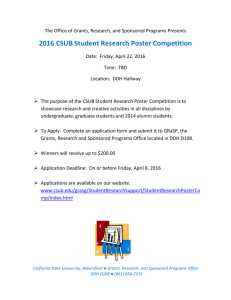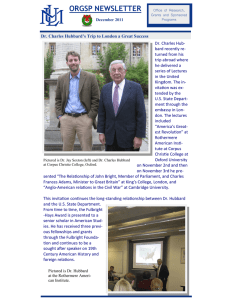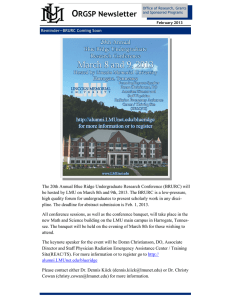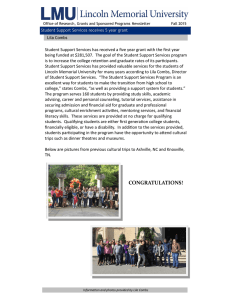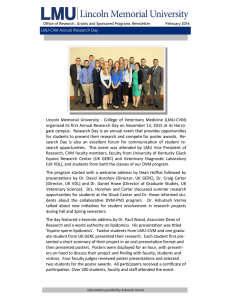Talking with Marybeth Babos is ... herbs. I left her office in the DeBusk College...
advertisement
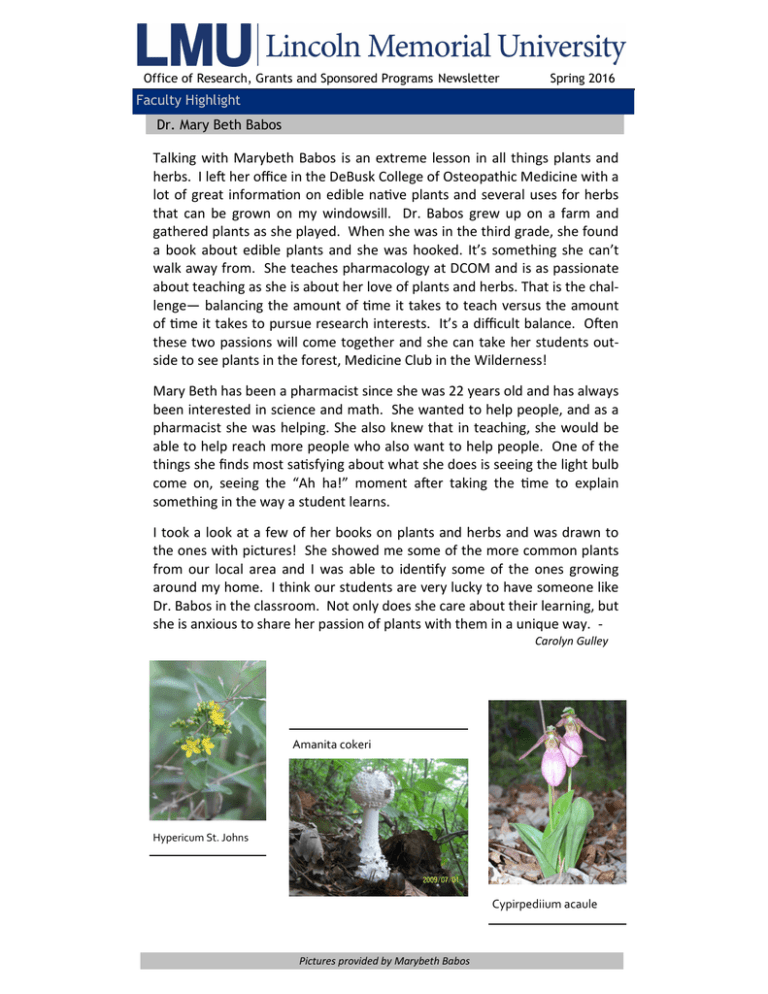
Office of Research, Grants and Sponsored Programs Newsletter Spring 2016 Faculty Highlight Dr. Mary Beth Babos Talking with Marybeth Babos is an extreme lesson in all things plants and herbs. I left her office in the DeBusk College of Osteopathic Medicine with a lot of great information on edible native plants and several uses for herbs that can be grown on my windowsill. Dr. Babos grew up on a farm and gathered plants as she played. When she was in the third grade, she found a book about edible plants and she was hooked. It’s something she can’t walk away from. She teaches pharmacology at DCOM and is as passionate about teaching as she is about her love of plants and herbs. That is the challenge— balancing the amount of time it takes to teach versus the amount of time it takes to pursue research interests. It’s a difficult balance. Often these two passions will come together and she can take her students outside to see plants in the forest, Medicine Club in the Wilderness! Mary Beth has been a pharmacist since she was 22 years old and has always been interested in science and math. She wanted to help people, and as a pharmacist she was helping. She also knew that in teaching, she would be able to help reach more people who also want to help people. One of the things she finds most satisfying about what she does is seeing the light bulb come on, seeing the “Ah ha!” moment after taking the time to explain something in the way a student learns. I took a look at a few of her books on plants and herbs and was drawn to the ones with pictures! She showed me some of the more common plants from our local area and I was able to identify some of the ones growing around my home. I think our students are very lucky to have someone like Dr. Babos in the classroom. Not only does she care about their learning, but she is anxious to share her passion of plants with them in a unique way. Carolyn Gulley Amanita cokeri Hypericum St. Johns Cypirpediium acaule Pictures provided by Marybeth Babos Office of Research, Grants and Sponsored Programs Newsletter Spring 2016 Society for Economic Botany Meeting Submissions from a recent meeting 1. Examining Non-Lethal Doses of Alpha Amanitin in C. elegans Authors: James N. Conner, OMS, Marybeth Babos, PharmD, Melissa Henderson, PhD Amatoxins are a subgroup of at least eight toxic cyclic octapeptides that occur in several genera of mushroom, including those of the genus Amanita. Human ingestion of these mushrooms is usually fatal, with toxicity manifesting in tissues that possess high rates of protein synthesis due to the ability of the toxins to inhibit RNA polymerase II. We studied the cellular effects of the constituent alpha amanitin using the model organism Caenorhabditis elegans. C.elegans, a nematode known for demonstrating genetic and molecular effects analogous to humans, is inherently sensitive to the amatoxins including alphaamanitin. We examined the effect of the toxin in non-lethal concentrations to determine the influence on larval growth and development, on the induction of apoptosis in the germline of C.elegans, and on the level of gene expression of several mRNAs involved in apoptosis. Further, we compared the effects of commercially available amanitin to a crude extract derived from Amanita virosa in order to determine whether there is an “entourage effect” from other constituents in the fungus. Our studies have outlined a novel approach to examine the actions of nature-derived compounds using C.elegans as a model. 2. The Development of a Validated Tool to Record the Medicinal Uses of Local Appalachian Plants Authors: Sadie R. Garita, OMS Fellow, Dr. Douglas Weston, DO, Marybeth Babos, PharmD The Appalachian region is plagued by an opiate overuse problem. Our initial pilot study sought to explore how herbs are used for pain in the Appalachian area, to develop an efficient self-survey method to gather ethnobotanical information, and to gather information from which to compare local medicinal herb use to that of Traditional Chinese Medicine. An IRB-approved self-survey was distributed at an herbal conference for participants to complete in detail on their use of plants for analgesia. This initial study demonstrated that a mail-sent survey was not an effective means to gather information in part due to ambiguities associated with word and in part due to the small number (N=2) of surveys actually returned. The differences in word usage between Western trained medical personnel and lay persons led us to expand the scope of the study. We plan to shift the focus to cataloguing the various plant uses so that we may apply data mining techniques to estimate probabilities that a given plant is used for a given Submissions provided by M.B. Babos Office of Research, Grants and Sponsored Programs Newsletter Spring 2016 News from the Paul V. Hamilton School of Arts, Humanities and Social Sciences Submissions continued purpose. As we organize the reported uses into validated text clusters, we will better identify how pain etiology might impact herb selection. Our reporting of this small study led a cohort of researchers to begin to collaborate. One group plans to develop Caenorhabditis elegans as a potential screening model for herb activity. Another emerging collaboration involves initial screening for herbs with potential antibacterial activity. Further, organization of plant use based upon text clusters will facilitate comparisons across cultures. We plan to correlate Appalachian use with Traditional Chinese use for comparisons at the constituent level. Though our initial pilot failed its purpose, it has led us to redirect for multipurpose results. This report demonstrates how human interactions with plants can lead to improved human interactions with humans. 3. Luteolin and its effect on V-ATPase Authors: Kenneth Dexter, OM, Marybeth Babos, PharmD, Melissa Henderson, PhD Luteolin is a naturally occurring flavonoid that is sold as an over the counter dietary supplement. Plants rich in luteolin have long been used in Chinese medicine to treat a variety of ailments. Recent research has shown that luteolin inhibits the V-ATPase enzyme in cells. V-ATPase is a proton pump that works both on the cell surface and on the surface of many organelles including endosomes, lysosomes, and secretory vesicles. It acts by using energy from ATP to create a transmembrane hydrogen ion gradient which is often used to drive many secondary active transports. Although luteolin is said to have a number of health benefits, the direct mechanism of action is unknown. We have used the model organism Caenorhabditis elegans to further investigate how luteolin affects the V-ATPase. Here we demonstrate the effect of luteolin on the V-ATPase on the growth and development of the nematode, its brood size, and the function of the VATPase in the sperm secretory vesicles. This study contributes to the establishment of C. elegans as a screening model for compounds found in medicinal herbs. Submissions provided by M.B. Babos Office of Research, Grants and Sponsored Programs Newsletter Spring 2016 News from the Paul V. Hamilton School of Arts, Humanities and Social Sciences Rachel Boillot 38630. Old Post Office, Farrell, Mississippi The article, “The Disappearing Post Offices of the Rural South”, written by David Rosenberg was recently published in The Slate, an online magazine of news, politics, technology and culture. The article features Adjunct Professor of Art, Rachel Boillot’s photography as well as her interests in Appalachian Folklore. Pictured are some of the photographs from the article. http://www.slate.com/blogs/ behold/2016/04/03/rachel_boillot_s_post_script_looks_at_disappearing_post_offices_in_the_rural.html 41307. Old Post Office, Athol, Kentucky 71316. David at the Old Post Office , Acme, Louisiana Information provided by Rachel Boillot Office of Research, Grants and Sponsored Programs Newsletter Spring 2016 News from Student Support Services Biltmore House On April 2, 2016, students and staff from the Lincoln Memorial University Student Support Services program enjoyed a visit to the Biltmore House in Asheville, NC, the largest privately owned home in America. While there, students enjoyed touring the 250 room house as well as the beautiful gardens where spring flowers such as tulips, daffodils, and azaleas were in full bloom. While in Asheville, they also enjoyed a shopping spree to the Asheville Mall. The Student Support Services Program serves 160 qualifying students on the campus of Lincoln Memorial University and provides, advising, tutoring, counseling, mentoring, and career planning to help students succeed in a post-secondary education. For more information about the program, please contact Lila Combs, Director at 423-869-6213. In the spring I have counted one hundred and thirty-six different kinds of weather inside of four and twenty hours. ~Mark Twain Office of Research, Grants and Sponsored Programs Newsletter Spring 2016 News from the School of Math and Science Guest Lecture The Department of Biology, in association with the ORGSP, presented a guest lecture given by Dr. Steve Stephenson, PhD, Research Professor in the Department of Biological Sciences at the University of Arkansas, Fayetteville. The lecture was titled, “Subantarctic Macquarie Island: A Scientific Adventure of a Lifetime.” Dr. Stephenson highlighted the adventure associated with being dropped off for four months on an extremely isolated island in the South Seas to conduct research with essentially no communication to the outside world. News from the Institutional Review Board Thesis and Dissertation Information The LMU IRB is responsible for reviewing ALL research involving human subjects conducted by faculty, staff and students under the DHHS OHRP FederalWide Assurance filed by the University. This applies to research that is conducted under the sponsorship of or in collaboration with other institutions. The question of whether or not LMU students are research participants is not the only issue involved in the determination of the level of engagement of LMU in a research project conducted by a faculty or staff member for a thesis or dissertation. LMU may be directly or indirectly engaged in the research. Direct engagement may occur through using students or staff as participants, tuition reimbursement, reassigned (release) time to complete a dissertation, or even reimbursement for travel to defend a dissertation. Indirect engagement may be related to visiting a research site where the researcher is known as an LMU faculty member, using any equipment or facilities in support of the research (telephone, copier, computer, office, library), or even reporting progress on the research in workload/evaluation documents that may support accreditation. For questions concerning the IRB contact Teresa Creech at 423.869.6749 or teresa.creech@lmunet.edu. IRB Information provided by Kay Paris Office of Research, Grants and Sponsored Programs Newsletter Spring 2016 Foundation Corner by Martha Scheidler We are all about success here, right? But how do we define success? Professors want their students to learn, understand, expand their thinking, experience creativity, and discover their unique gifts. Administrators want their departments to be efficient. Students want to graduate. Parents want their children to…well, that’s a tough one. To be happy, independent, functional adults? Everyone has their own definition of success. As grant writers, success is not always measured in dollars. The fact of the matter is that grant development is a numbers game. Finding a foundation with giving priorities that match the project, in the funding range needed, and within the application time limit can be tricky, and frustrating. The ability to get from a letter of intent to a proposal, and getting the proposal before the grant committee or the foundation trustees is sometimes success in itself. Actually receiving funding is icing on the cake, but, let’s just say the odds are not good. So why try? Nothing is ever wasted. A well written narrative is a great boilerplate for future submissions. A well planned budget can be pared down or increased if the potential grant allows. The program, after all, should be scalable depending on the number of people served and the extent of services offered. Invariably a funder will ask about program sustainability. As Vu Le so brilliantly and sarcastically states in his blog on non-profit management, one can always cite the “Synergistic Paradigm Action Matrix” as a means of program sustainability. Aside from the obvious obfuscation, there is little that can be done with the sustainability question other than be as transparent as possible. If the program is dependent on foundation funding and can’t go forward without it, it’s best to state that. That does not mean the program is without merit. It just needs the right funder. Every narrative is an opportunity to fine tune a program. Start with the basics: what, why, how, who, when. As opportunities come along for submission, build on the basics. Always be clear and concise. Think entrepreneurially, avoid technical jargon, be compelling, and passionate. That spells success in grant writing. Photo by Tom Mackie Office of Research, Grants and Sponsored Programs Newsletter Spring 2016 Recent Submissions and Awards Submissions: Richard Vogel has submitted a grant to South Arts Southern Circuit to host independent films. Brandon Lutterman has submitted a grant to ArtPlace America for Arts in the Gap. Mary Ann Searle and Rick Stowe have submitted a grant to the North Face Foundation for the High Adventure program. Mary Ann Searle has submitted an application to the Outdoor National Campus Challenge to support outdoor activities on campus. Leah Cobb and Tony Maxwell have submitted a grant to the Dr. Scholl Foundation, Good Samaritan Foundation, the Talloires MacJannet Prize, the CSX Foundation, and the State Farm Youth Advisory Board in support of SOMA’s Heart to Heart program at Middlesboro Elementary School. Dominic Palazzolo has filed a grant with the Respiratory Fund of the East Tennessee Foundation for a study to determine the effectiveness of ECIGs as a harm reduction alternative to smoking. Darnell Arnoult submitted a grant to the Literary Fund of the East Tennessee Foundation in support of the Mountain Heritage Literary Festival. Steven Wilson submitted a proposal to Humanities Tennessee. Dawn Spangler submitted a proposal for a Johnson and Johnson Suture Grant. Ashutosh Verma submitted a proposal to the Morris Animal Foundation Jason Johnson submitted a proposal to the USDA National Institute of Food and Agriculture. Timothy York submitted a proposal to the Robert Wood Johnson Foundation’s Clinical Scholars Program. Awards: Jeff Phillips was awarded a grant from Merial, Inc. Cindy Whitt has been awarded a grant from the Women’s fund of East Tennessee for theCORE Leadership Symposium, a summer week-long campus residency program for high school women rising seniors in Union and Claiborne Counties. Appalachian College Association has awarded Ledford Scholar Awards to students, Katelyn Vermilyea and Julianne White for student research projects. Katelyn’s faculty advisor is Dr. Kay Paris and Julianne’s faculty advisor is Dr. Paul Wood. CONGRATULATIONS! Office of Research, Grants and Sponsored Programs Newsletter Spring 2016 Contact Information for Research, Grants and Foundations Marca Cenatiempo Director, Health Sciences Research and Grants marca.cenatiempo@lmunet.edu (423) 869-6838 Teresa Creech Research Committees Coordinator teresa.creech@lmunet.edu (423) 869-6749 Carolyn Gulley Executive Director, Office of Research, Grants and Sponsored Programs carolyn.gulley@lmunet.edu (423) 869-6291 Kimberly Kertis Research Specialist, Health Sciences Kimberly.kertis@lmunet.edu (423) 869-6441 Dennis Kiick Vice President for Research dennis.kiick@lmunet.edu (423) 869-7086 Melissa Miracle Post Award Grants Manager melissa.miracle02@lmunet.edu (423) 869-6834 Martha Scheidler Director of Foundations martha.scheidler@lmunet.edu (423) 869-6398 Reminder from the LMU Institutional Review Board Please remember that all research proposals and projects involving human subjects, must have IRB approval prior to the presentation of any information gathered during the course of the research. Under federal policy, the IRB cannot grant retroactive IRB approval. If your grant award, application, presentation, or publication has not been mentioned in this edition, please forward your information to us using the contact information listed. The ORGSP is located in Duke Hall, Suite 304 As a reminder, all applications for external funding must first begin by contacting the ORGSP.
